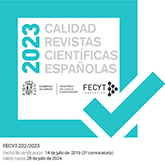Nuove soluzioni funzionali nelle domus tardoantiche di Ostia attraverso la lettura delle tecniche edilizie e delle tipologie architettoniche
DOI:
https://doi.org/10.3989/aespa.2004.v77.98Keywords:
Tipology architectonique, Domus late antiqueAbstract
This research project has as its base my degree thesis. The latter attempted to create new methodology techniques that could be used to identify different phases of building construction. The study focussed in particular on three late antique domus in Ostia: the Domus of the Caupona, the Domus of the Gorgons and the Domus of the Decumanus. Such a study, based on both the stratigraphie records of the standing structures and the analysis of the archives, has allowed me to develop a new methodology, that differs quite markedly from the traditional methods currently used to analyse and date building techniques. The results of this research challenge the common opinion that the late antique domus were built following a single and unitary project. Many different phases have been identified, suggesting that these buildings had a more complex history than previously thought. This evolution must be viewed in the light of social and economic transformations occurring in Late Antiquity i.e.3rd/ 5th century AD. A number of conclusions can be drawn. Firstly, different building projects/phases can be seen in these domus (probably due to the different needs of the customers) and, consequently, also a more various range of plans and typologies. Secondly, analysing a wider number of buildings, it has also been possible to suggest new chronologies and functions for some building techniques. Finally the analysis has been extended to the entire city, identifying a new pattern of building location and function within the urban area in Late Antiquity.
Downloads
Download data is not yet available.
Downloads
Published
2004-12-30
How to Cite
Tigne, R. (2004). Nuove soluzioni funzionali nelle domus tardoantiche di Ostia attraverso la lettura delle tecniche edilizie e delle tipologie architettoniche. Archivo Español De Arqueología, 77(189-190), 221–238. https://doi.org/10.3989/aespa.2004.v77.98
Issue
Section
Articles
License
Copyright (c) 2004 Consejo Superior de Investigaciones Científicas (CSIC)

This work is licensed under a Creative Commons Attribution 4.0 International License.
© CSIC. Manuscripts published in both the printed and online versions of this Journal are the property of Consejo Superior de Investigaciones Científicas, and quoting this source is a requirement for any partial or full reproduction.All contents of this electronic edition, except where otherwise noted, are distributed under a “Creative Commons Attribution 4.0 International” (CC BY 4.0) License. You may read here the basic information and the legal text of the license. The indication of the CC BY 4.0 License must be expressly stated in this way when necessary.
Self-archiving in repositories, personal webpages or similar, of any version other than the published by the Editor, is not allowed.














